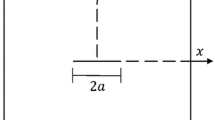Abstract
The main purposes of the present paper are as follows: (1) to analytically derive the general solution (stress functions) for an orthotropic elastic half plane with a crack or a notch; (2) to derive the Riemann–Hilbert equation as the analytical method; (3) to solve the present problem using two methods, one is a Cauchy integral method and other is a Riemann–Hilbert method; and (4) to derive the general expressions of the stress intensity factor (SIF) for a crack problem. The stress functions obtained by the Riemann–Hilbert equation are compared with those obtained by Cauchy integral method. Then, it is confirmed that the same stress functions can be obtained. The stress functions are expressed by any elastic constants. Therefore, Mode I and II SIFs can be calculated for any elastic constants. Some examples are shown. It is stated from the results of the examples that the negative Mode I SIFs exist for certain oblique edge crack angles and elastic constants. Because the derived stress functions are expressed using a mapping function, other geometrical shapes can be analyzed by changing the mapping function.







Similar content being viewed by others
References
Lekhnitskii, G.C.: Theory of an anisotropic elastic body. Holden Day, San Francisco (1963)
Lekhnitskii, G.C.: Anisotropic plates. Gorden and Breach Sciences, New York (1968)
Hasebe, N.: Analysis of an orthotropic elastic plane problem of a half pane with an edge crack using a mapping function. Acta Mech. 230, 2813–2826 (2019)
Daoust, J., Hoa, S.V.: An analytical solution for anisotropic plates containing triangular holes. Compos. Struct. 19, 107–130 (1991)
Hwu, C.: Polygonal holes in anisotropic media. Int. J. Solids Struct. 29(19), 2369–2384 (1992)
Ukadgaonker, V.G., Rao, D.K.N.: Stress distribution around triangular holes in anisotropic plates. Compos. Struct. 45, 171–183 (1999)
Ukadgaonker, V.G., Kakhandki, V.: Stress analysis for an orthotropic plate with an irregular shaped hole for different in-plane loading conditions—part I. Compos. Struct. 70, 255–274 (2005)
Zappalorto, M., Carraro, P.A.: Stress distributions for blunt cracks and radiuses slits in anisotropic plates under in-plane loadings. Int. J. Solids Struct. 56–57, 136–141. M.P. (2015)
Hwu, C., Hsu, C.L., Chen, W.R.: Corrective evaluation of multi-valued complex functions for anisotropic elasticity. Math. Mech. Solids 22(10), 2040–2062 (2017)
Zappalorto, M., Carraro, P.A.: Two-dimensional stress distributions in tensioned orthotropic plates weakened by blunt V-shaped notches. Fatigue Fract. Eng. Mater. Struct. 40, 804–819 (2017)
Zappalorto, M.: On the stress state in rectilinear anisotropic thick plates with blunt cracks. Fatigue Fract. Eng. Mater. Struct. 40, 103–119 (2017)
Zappalorto, M.: Mode I Generalised Stress Intensity Factors for rounded notches in orthotropic plates. Theor. Appl. Fract. Mech. 101, 356–364 (2019)
Hasebe, N., Inohara, S.: Stress analysis of a semi-Infinite plate with an oblique edge crack. Archive Appl. Mech. 49, 51–62 (1980)
Hasebe, N., Sato, T.: Stress analysis of quasi-orthotropic elastic plane. Int. J. Solids Struct. 50, 209–216 (2013)
Savin, G.N.: Stress concentration around holes. Pergamon Press, London (1961)
Suo, Z.: Singularities interface and cracks in dissimilar anisotropic media. In: Proceedings of the Royal Society of London. Ser. A Math. Phys. Sci. 427–1873, 331–358 (1990)
Muskhelishvili, N.I.: Some basic problems of the mathematical theory of elasticity. Noordhoff, Groningen (1963)
Hasebe, N.: Stress concentration and stress analyses for certain orthotropic plates. Trans. Civ. Eng. Jpn. Soc. Civ. Eng. 233, 1–11 (1975) (in Japanese)
Hasebe, N., Iida, J.: A crack originating from a triangular notch on a rim of a semi-infinite plate. Eng. Fracture Mech. 10–4, 773–782 (1978)
Sih, G.C.: Cracks in materials possessing homogeneous anisotropy. In: Sih GC (ed), Chap. 1 in Plates and Shells with cracks. Leyden, Netherlands (1977)
Author information
Authors and Affiliations
Corresponding author
Additional information
Publisher's Note
Springer Nature remains neutral with regard to jurisdictional claims in published maps and institutional affiliations.
Appendix 1
Appendix 1
The method to calculate stress intensity factors (SIFs) of Modes I and II is stated. The crack in the physical plane shown in Fig. 4a is first considered. The small distance “r” on the extended crack line at the crack tip is considered. The crack on the x-axis must be considered. The crack in the physical plane is shown in Fig. 4b. The crack in the analytical plane is shown in Fig. 5b.
The coordinate \(\sigma_{10}\) at the crack tip C1 on the unit circle on the \(z_{1}\hbox{-}\)plane is
which is derived from the first derivative
The crack surfaces are rotated on the x1-axis (see Fig. 5), and the following equation using Eqs. (45), (53) and (66) is derived:
The first term in Re[] of the above equation is considered:
and the second term (see Eq. (52))
Therefore,
Similarly, using \(\tau_{xy}\) in Eq. (63), the equation for k2 is derived:
Rights and permissions
About this article
Cite this article
Hasebe, N. Stress analysis for an orthotropic elastic half plane with an oblique edge crack and stress intensity factors. Acta Mech 232, 967–982 (2021). https://doi.org/10.1007/s00707-020-02894-2
Received:
Revised:
Accepted:
Published:
Issue Date:
DOI: https://doi.org/10.1007/s00707-020-02894-2




